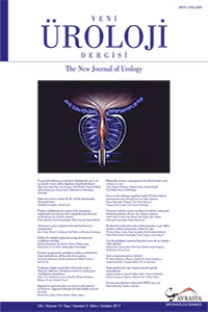YouTube videoları Penil Doppler Ultrasonografi hakkında güvenilir bilgiye sahip mi?
Penil, Doppler, Ultrasonografi, YouTube
Does YouTube videos have reliable information on Penile Doppler Ultrasonography?
Penile, Doppler, Ultrasonography, YouTube,
___
- Fode M, Nolsøe AB, Jacobsen FM, et al. Quality of information in YouTube videos on erectile dysfunction. Sexual Medicine. 2020; 8(3):408-413. DOI:10.1016/j.esxm.2020.05.007.
- Borgmann H, Salem J, Baunacke M, et al. Mapping the landscape of urology: a new media‐based cross‐sectional analysis of public versus academic interest. International Journal of Urology. 2018; 25(5):421-428. DOI:10.1111/iju.13527.
- Sansone A, Cignarelli A, Ciocca G, et al. The sentiment analysis of tweets as a new tool to measure public perception of male erectile and ejaculatory dysfunctions. Sexual Medicine. 2019; 7(4):464-471. DOI:10.1016/j.esxm.2019.07.001.
- Gratzke C, Angulo J, Chitaley K, et al. Anatomy, physiology, and pathophysiology of erectile dysfunction. The Journal of Sexual Medicine. 2010; 7(1):445-475. DOI:10.1111/j.1743-6109.2009.01624.x.
- Sikka SC, Hellstrom WJ, Brock G, et al. Standardization of vascular assessment of erectile dysfunction. The Journal of Sexual Medicine. 2013; 10(1):120-129. DOI: 10.1111/j.1743-6109.2012.02825.x.
- Bernard A, Langille M, Hughes S, et al. A systematic review of patient inflammatory bowel disease information resources on the World Wide Web. Official journal of the American College of Gastroenterology|ACG. 2007; 102(9):2070-2077. DOI: 10.1111/j.1572-0241.2007.01325.x.
- Charnock D, Shepperd S, Needham G, et al. DISCERN: an instrument for judging the quality of written consumer health information on treatment choices. Journal of Epidemiology & Community Health. 1999; 53(2):105-111. DOI: 10.1136/jech.53.2.105.
- Silberg WM, Lundberg GD, Musacchio RA. Assessing, controlling, and assuring the quality of medical information on the Internet: Caveant lector et viewor-Let the reader and viewer beware. Jama. 1997; 277(15):1244-1245. DOI: 10.1001/jama.1997.03540390074039.
- Gul M, Diri MA. YouTube as a source of information about premature ejaculation treatment. The journal of sexual medicine. 2019; 16(11):1734-1740. DOI:10.1016/j.jsxm.2019.08.008.
- Warren CJ, Sawhney R, Shah T, et al. YouTube and Men’s Health: A Review of the Current Literature. Sexual Medicine Reviews. 2021; 9(2):280-288. DOI: 10.1016/j.sxmr.2020.09.002.
- Ovenden CD, Brooks FM. Anterior cervical discectomy and fusion YouTube videos as a source of patient education. Asian Spine Journal. 2018; 12(6):987. DOI: 10.31616/asj.2018.12.6.987.
- Salman MY, Bayar G. Evaluation of quality and reliability of YouTube videos on female urinary incontinence. Journal of Gynecology Obstetrics and Human Reproduction. 2021; 50(10):102200. DOI: 10.1016/j.jogoh.2021.102200.
- Ozsoy‐Unubol T, Alanbay‐Yagci E. YouTube as a source of information on fibromyalgia. International Journal of Rheumatic Diseases. 2021; 24(2):197-202. DOI: 10.1111/1756-185X.14043.
- Taylor J, Loeb S. Guideline of guidelines: social media in urology. BJU international. 2020; 125(3):379-382.10.1111/bju.14931.
- Warren C, Paskhover B, Sadeghi-Nejad H. Re: YouTube as a Source of Information About Premature Ejaculation Treatment. The Journal of Sexual Medicine. 2019;17(2):357-358. DOI: 10.1016/j.jsxm.2019.11.268.
- Tanwar R, Khattar N, Sood R, et al. Benign prostatic hyperplasia related content on YouTube: unregulated and concerning. Recenti Progressi in Medicina. 2015; 106(7):337-341. DOI: 10.1701/1940.21092.
- ISSN: 1305-2489
- Yayın Aralığı: 3
- Başlangıç: 2005
- Yayıncı: Pera Yayıncılık
Kübra ÖZGÖK KANGAL, Kübra CANARSLAN DEMİR
Hematürinin nadir bir nedeni intravezikal ektopik gebelik; olgu sunumu
Adem TUNÇEKİN, Adnan İNCEBIYIK, Mehmet DEMİR, İsmail YAĞMUR, Eyyup Sabri PELİT, Bülent KATI, Halil ÇİFTÇİ
Ürolojik robotik cerrahilerde bölgesel analjezi tekniklerinin etkinliği: retrospektif klinik çalişma
Sami Kaan COŞARCAN, Alper Tunga DOĞAN, Mert KILIÇ, Ömür ERÇELEN
YouTube videoları Penil Doppler Ultrasonografi hakkında güvenilir bilgiye sahip mi?
Doğukan SÖKMEN, Bedriye KOYUNCU SÖKMEN, Zülfü SERTKAYA, Emin Taha KESKİN
Cevper ERSÖZ, Abdullah İLKTAÇ, Senad KALKAN, Yunus KAYALI, Habib AKBULUT, Hüseyin TOPRAK, Bayram DOĞAN
COVİD-19 pandemisinin Türkiye’deki üroloji asistanlığındaki etkisi
Arif KALKANLI, Nusret Can ÇİLESİZ, Cem Tuğrul GEZMİŞ, Coskun KAYA, Onur FİKRİ, Ateş KADIOĞLU
Prostat füzyon biyopsisi ile ilgili YouTube videolarındaki bilgilerin kalitesi
